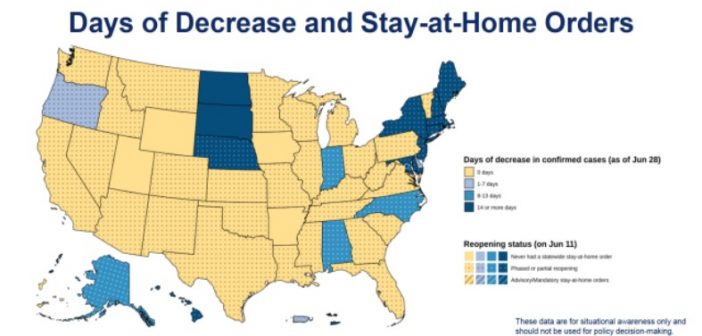As the United States struggles to contain the spread of the coronavirus, focus has turned to California, Arizona, Texas and Florida, which have seen dramatic spikes in recent days. But a map from an internal document produced by the Centers for Disease Control and Prevention (CDC) obtained by Yahoo News shows that as many as 32 states are not seeing decreases in COVID-19 cases.
The map is a starkly visual reminder that many of the states have ignored CDC guidance, which recommended not reopening until they had achieved 14 days of declining cases.
Another map, produced by the Department of Health and Human Services and the Department of Homeland Security and obtained by Yahoo News, shows that positive lab test results for the coronavirus increased to nearly 8 percent nationwide last week. Two weeks ago, Vice President Mike Pence, in an op-ed that sought to downplay what he called “panic” over the coronavirus, boasted that the country’s positivity rate had fallen to 6 percent.
According to CDC data, the United States has seen 40,000 new positive COVID-19 cases on each of the past four days. Only one other previous day, April 6, saw that many.
“I think the numbers speak for themselves,” Dr. Anthony Fauci, the nation’s top infectious disease expert, said Tuesday in an appearance before a Senate panel on the administration’s response to the pandemic.
“Clearly we are not in total control right now,” Fauci said, pointing to the dramatic rise in cases, particularly in the South.
“If you look at what’s going, and just look at some of the film clips of people congregating, often without masks, and being in crowds, jumping over and avoiding and not paying attention to the guidelines that we carefully put out, we are going to continue to be in a lot of trouble,” he said.
“I will not be surprised if this goes up to 100,000 cases a day if this doesn’t turn around,” he added when pressed to make a prediction.
Fauci would not speculate on the U.S. death toll, which has risen to more than 126,000, according to tracking from Johns Hopkins University. But he added: “I think it is important to tell you and the American public that I’m very concerned, because it could get very bad.”
The virus has been surging across Southern and Western states, with case totals doubling in June in at least 10 states. The governors of Oregon and Kansas have issued statewide mask mandates, while Texas and Arizona have begun rolling back their reopenings as cases surge. County officials in South Florida have announced they will be closing beaches over the Fourth of July weekend in an attempt to slow the rise in cases there.
On Monday, Dr. Anne Schuchat, principal deputy director of the CDC, said the virus was spreading too rapidly and too broadly for the U.S. to bring it under control.
“We’re not in the situation of New Zealand or Singapore or Korea, where a new case is rapidly identified and all the contacts are traced and people are isolated who are sick and people who are exposed are quarantined and they can keep things under control,” she said in an interview with the Journal of the American Medical Association’s Dr. Howard Bauchner. “We have way too much virus across the country for that right now, so it’s very discouraging.” ♦
This article originally appeared in The Yahoo News.




